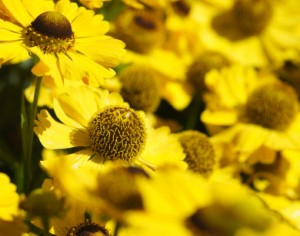Helenium
 Known as ‘Helen’s flower’, Heleniums are often displayed with other plants such as solidago, rudbeckias and heliopsis to introduce colour to an arrangement. They are seen as being part of the daisy family, which is down to their small flowers and multiple petals.
Known as ‘Helen’s flower’, Heleniums are often displayed with other plants such as solidago, rudbeckias and heliopsis to introduce colour to an arrangement. They are seen as being part of the daisy family, which is down to their small flowers and multiple petals.
Description
Most species in the genus resemble daisies, in that they have small petals and a long, thin stalk. However, some species have a flower where the centre sticks out while the petals tend to form a circle below. They come in a number of shades, including crimson, pink and orange.
Habitat
Helenium is believed to have originated in North America, although it was brought to Europe in the 18th century, where many species can still be found today. They were most commonly found in the eastern regions of the United States and parts of Southern Canada with more temperate climates.
Availability
Most species flower during the summer between June and August, although some varieties flower later on in the year. Heleniums tend to like full sunlight, so need plenty of exposure during the summer months to thrive.
Species
The most common of the 40 or so species of Helenium is the H. Autumnale, which is said to have healing qualities. Other common species include the H. Bigelovii, which adapts very well to wet, autumnal conditions, and ‘Moerheim Beauty’, which usually blooms during hot, dry summers.
Care Tips
Most varieties of Helenium require great amounts of sunlight to help them grow. They need alluvial loam and soil which can soak up plenty of moisture as well. Should your soil be light, using organic matter could help to improve growing conditions. It’s best to plant most species around March, but if taken care of properly, some species can last well into November.
Did you know?
When it only grew in North America, Cherokee Indians turned Helenium Autumnale flowers into a powder which was used as a cure for colds.
References
http://www.telegraph.co.uk/gardening/howtogrow/3343654/How-to-grow-heleniums.html
http://www.bbc.co.uk/gardening/plants/plant_finder/plant_pages/374.shtml


